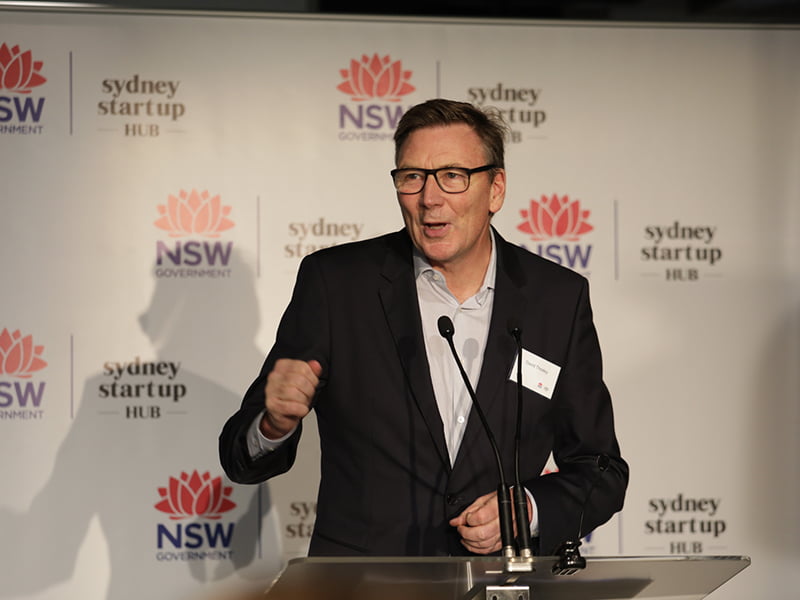The ribbon has now been cut on the stunning new Sydney Startup Hub – home to 2,500 entrepreneurs and a Microsoft global accelerator – but David Thodey is looking elsewhere, and says there is already an urgency attached to finding more space for the sector to grow.
The scale of the $35 million Sydney Startup Hub has already further shifted the centre of gravity of Australian startup ecosystem. The arrival of the Microsoft ScaleUp program into the facility is evidence of this.
The hub is highly marketable across startup ecosystems around the world, and the state government has an international program of activity ready to roll-out in order to sell the facility across the globe. It will become a focal point for inbound trade missions and innovation tourists.

But the Sydney Startup Hub was only ever intended as a stop-gap measure, with a limited horizon. As impressive as the pace at which the hub was pulled together – 18 months from idea to opening – the debates about where to go next have not gone away.
David Thodey says the initial five-year horizon of the Jobs for NSW $35 million investment in the Sydney Startup Hub was a short one. Getting a bigger and more permanent home for the ecosystem will require an urgency of action right now.
“The intent is to make it self-sustaining after five years, and also we are going to be looking for a bigger precinct,” Mr Thodey told InnovationAus.com.
“This was always intended as an initiative for five years, where we see how it goes and if we can build something bigger and grander, then we will.”
Mr Thodey, who is chairman of both Jobs for NSW and the CSIRO, says “all the usual suspects” for sites for a geographic centre for tech startups and entrepreneurs in Sydney are still under consideration – the Powerhouse, the CarriageWorks/ATP area, Central station, even the Gas Works – all of which will require substantial works (and approvals processes).
Mr Thodey is not involved in the decision-making, but in order to get it done, “you’ve got to start now.”
“It’s an active discussion [that has] really been at the grass roots level. So you’ve got to work it through management, and we will have to talk it through with the government about what they think is the best thing to do.
Critical to the decisions about location will be how to get the Universities involved. The sites being considered differ in the way they can integrate the UTS, Sydney University and the University of NSW.
Ultimately a more complete strategy would include a Greater Sydney view in addition to the inner city focus and build-in integrated plans for the University of Western Sydney and Macquarie.
Mr Thodey said another issue of rising urgency in Australia – and other ecosystems around the world – related to access to skills.
While the tightening of the 457 visa program was “probably not helpful at a macro level’, he said where unique skills were required, it was still possible to access talent through the program.
Regardless of where you draw the line, the point is that access to skills is fundamentally critical to growth in the ecosystem.
“Because it is a global market, you need to be able to have easy global movement of talent,” Mr Thodey said. “That’s really important.”
“I am very conscious that we want to look after Australia, but we don’t want a protectionist Australia. We want an open-for-business Australia,” he said.
“So I hope that we can work through this and where we need skills we can bring them in.
“But we also want to be creating an ecosystem where we are exporting skills as well, and where we are really a part of that global market [for talent].”
Microsoft Australia managing director Steve Worrall says the access to skills issue represented the single biggest issue he has dealt with since taking the role a year ago – but he argues it is much broader than 457’s and cannot be properly dealt with simply with temporary visas.
Access to skills is an issue “not just for us as an organisation, but also for the clients and partners that we work with, and for the startups that we work with,” Mr Worrall told InnovationAus.com.
“Last time I checked 457s covered only about 4 to 5 per cent of the total headcount in this country (in ICT). There are about 675,000 people work in ICT in Australia and 4 to 5 per cent of that is satisfied by 457 visa holders,” he said.
“And yet we know that there is about a 20,000 incremental demand [shortfall] every year. There are about 4,000 kids coming out of universities with STEM-related degrees. So there is a massive gap, and it’s not going to be filled by 457s, and is not going to be filled by Microsoft saying we have a global program and flying people in.”
“It has to be filled by a program of retooling and retraining existing workers.”
Do you know more? Contact James Riley via Email.

